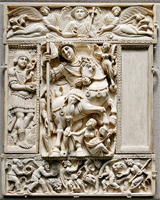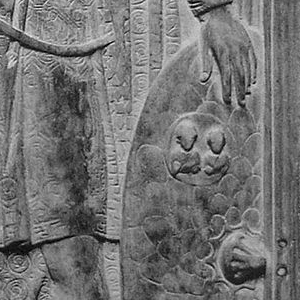
This page created 28 May 2014, and last modified: 22 August 2015 (Stilicho commentary added)

In the eastern half of the Empire, the Count of the Household Horse controls a single mounted bodyguard unit, called the Domestici equites (30.2 in Ingo Maier's numbering scheme). Its shield pattern (29#3) as shown in various manuscripts, under the label (29.a) Domestici equitum, is as below:

The pattern is ornate. The boss is purple and marked with quartering lines; it is surrounded by a further purple band and a narrow yellow band. This in turn is surrounded by a broad yellow band on which are inscribed 6 (B), 10 (O) or 11 (P, M, W) hearts (the hearts are purple rather than yellow in W). The main field is also purple and bears three charges in yellow: a circular imago (imperial portrait) at the 12 o'clock position, showing the heads and shoulders of two people; and flanking the imago, two winged Victories. It thus closely resembles the pattern of the Domestici Pedites under the (eastern) Count of the Household Foot.

Photo by Marie-Lan Nguyen and released into the public domain. |
It is unclear to what extent, if any, the Domestici were military guard units at this (or indeed, any) date as opposed to being purely ceremonial; they seem to have functioned more as a staff officers college than anything else. In the 350s, Ammianus records Constantius being protected on the field by 'praetorian' foot guards who may well be the same as the Domestici Pedites, but whether this guard survived into the 5th century as a military force is unclear. We also hear of protectores as bodyguards for commanders, but these do not find any place in the Notitia's organizational scheme.
Paired Victories flanking an imperial image are a characteristic late Roman motif, and can also be found on e.g. the Arch of Constantine (although in this case the imperial image has been lost; single Victories are also used on the same monument). The motif continued into the Byzantine era; the picture to the left of the early-6th century Barberini ivory in the Louvre shows how the Victories have been transformed into angels, and have been elevated to flanking Christ rather than the earthly emperor. |
| It is not immediately clear who the dual imperial portrait imago in the shield pattern represents. Given one of the personages appears larger than the other, a faint possibility is a Christian representation of Mary and infant Jesus, but this sort of imagery was very rare before 431, and in any case, would go against the paucity of Christian motifs in the Notitia. Instead, the image might well represent Arcadius and Honorius, who after their father Theodosius I's death in 395 were Augusti of the eastern and western halves of the empire, respectively. Arcadius was probably 17 at the time of his father's death, while Honorius was 11, so the respective sizes of the figures would well fit such an age difference if they represent the pair before a date of approximately 395, i.e. exactly when most observers believe the eastern portion of the Notitia was first compiled. An identical dual portrait, with individuals of the same relative sizes and positions, is seen on the shield of Stilicho on the well-known ivory diptych depicting him, his wife, and their son (detail on the right); Stilicho was himself the eastern Comes Domesticorum from 385 to 392, and the individuals shown on his shield can hardly refer to anybody else. |

Detail of the Stilicho diptych, now in Monza Cathedral; Public domain image originally from Pierce & Tyler, L'art byzantin, Paris, 1932. |
The pattern of the Domestici Equites in notable not only for its ornateness, but also because it belongs to an eastern cavalry unit: the only other cavalry units from the east that may have patterns shown are the eastern Scholae units, and which were also guards units. Why the Notitia compilation as it has come down to us lacks shield patterns for the regular eastern cavalry units is an unanswered question. It may be that a Carolingian copyist grew tired of drawing so many patterns, and yet the document may well have owed its continued existance in part because of the visual interest these very same patterns provided. But the selectivity of the omissions is striking: for example, amongst the infantry of the Magister Militum per Illyricum, it is the pseudocomitatenses units (i.e. recently-transfered limitanei units) - and only the pseudocomitatenses units - that are not illustrated. It appears quite likely that the "original" Roman compilation simply did not contain the "missing" shield patterns. Consider that while the other eastern Magistri's pages show up to two dozen patterns each, that of the Magister Militum per Illyricum shows only 15 in the same space, so there was certainly room enough to illustrate the "missing" 9 pseudocomitatenses units. Thus there is no reason to believe the missing regular eastern cavalry shields were omitted for reasons of space, anymore that there is a reason to believe that the "original" Roman compilation included them (I say "original" in quote marks, because it is possible that in Roman times there was no one single compilation, just a number of separate documents that were compilated only later, in e.g. Carolingian times).

Return to the Notitia alphabetical unit list page.
Return to my Notitia index page.